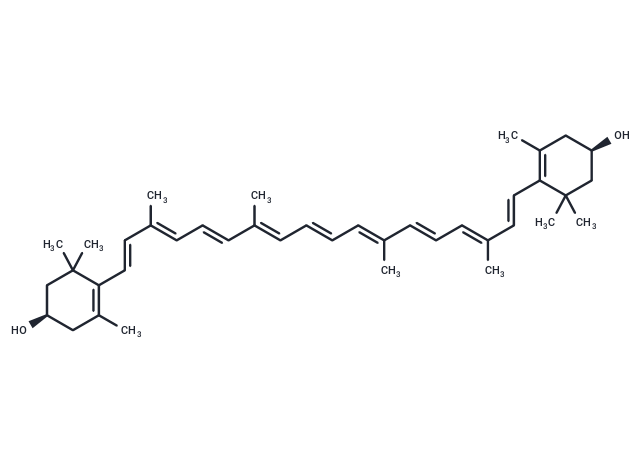Shopping Cart
- Remove All
 Your shopping cart is currently empty
Your shopping cart is currently empty

Zeaxanthin is a dietary carotenoid that accumulates in the retina (particularly the macula) and has antioxidant activity that may improve obesity, prevent age-related macular degeneration, and protect against nonalcoholic steatohepatitis.

| Pack Size | Price | Availability | Quantity |
|---|---|---|---|
| 1 mg | $64 | In Stock | |
| 5 mg | $198 | In Stock | |
| 10 mg | $355 | In Stock | |
| 25 mg | $596 | In Stock | |
| 50 mg | $793 | In Stock | |
| 100 mg | $1,120 | In Stock | |
| 500 mg | $2,230 | In Stock |
| Description | Zeaxanthin is a dietary carotenoid that accumulates in the retina (particularly the macula) and has antioxidant activity that may improve obesity, prevent age-related macular degeneration, and protect against nonalcoholic steatohepatitis. |
| In vitro | METHODS: Free fatty acid (FFA)-induced HepG2 cells were used as a cell model of NAFLD to study the role of Zeaxanthin in HepG2 cells. RESULTS Zeaxanthin exerts antioxidant and anti-inflammatory effects in FFA-induced HepG2 cells, can significantly reduce the production of reactive oxygen species (ROS) and iron overload, and improve mitochondrial dysfunction in FFA-induced HepG2 cells; Zeaxanthin can also down-regulate The expression of p53, regulating downstream targets such as GPX4, SLC7A11, SAT1 and ALOX15, helps reduce cellular lipid peroxidation. [2] |
| Alias | Anchovyxanthin |
| Molecular Weight | 568.87 |
| Formula | C40H56O2 |
| Cas No. | 144-68-3 |
| Smiles | C\C(\C=C\C=C(/C)\C=C\C1=C(C)C[C@@H](O)CC1(C)C)=C/C=C/C=C(\C)/C=C/C=C(\C)/C=C/C1=C(C)C[C@@H](O)CC1(C)C |
| Relative Density. | 1.008 g/cm3 |
| Storage | keep away from direct sunlight | Powder: -20°C for 3 years | In solvent: -80°C for 1 year | Shipping with blue ice. |
| Solubility Information | DMSO: Slightly soluble |

Copyright © 2015-2025 TargetMol Chemicals Inc. All Rights Reserved.